IAHS conference: live feed
Contributed by Marie-Amélie Boucher (Université de Sherbrooke) and Maria-Helena Ramos (Irstea)
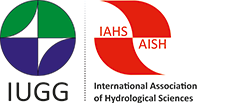 Cannot attend IAHS conference in Montreal this week? Follow us then!
Cannot attend IAHS conference in Montreal this week? Follow us then!
During this week, from Monday 8 to Saturday 13, we will be posting some lines and photos every day in the HEPEX blog, directly from the 27th IUGG General Assembly, at the Palais des Congrès in Montréal, Canada. You can post comments day by day too, and we will try to answer them all. Just remember: we will be in Montreal time zone (UTC−4)!
The IAHS workshops can be found in the program here.
Day 1: Sunday 7 July
Montreal Day 1
MHR: I have just arrived in Montreal. The flight went well, although getting out of the airport to the city centre was a bit tricky! I am looking forward to meeting new people and seeing ‘old’ ones this week at the conference. Before going to sleep, I still have to check my agenda for the week (busy, yes!), and try to find a moment in the next days to eat my favourite dish in Québec: la poutine!
MAB: The week will be very full! Besides the scientific sessions, my focus is also on the short course on ‘Ensemble streamflow forecasting and reservoir optimization’, organized by the YHS (Young Hydrologic Society). It will be held on Tuesday 9 July at 4pm, and I am sharing it with Professor Sara Séguin from Université du Québec à Chicoutimi. We have everything (almost) ready and I hope there will be plenty of early career scientists attending it!
No poutine for me, thank you very much! (Not a fan…)
Day 2: Monday 8 July
MHR: Do you know where the performance by Yoko Ono and John Lennon of “Give Peace a Chance” took place? I didn’t, but I learnt it today: at the Queen Elizabeth Hotel in Montreal (official English name ‘Fairmont The Queen Elizabeth’).
From May 26 to June 2, 1969, The Queen Elizabeth hotel welcomed John Lennon and Yoko Ono for their Bed-in for Peace (here)
It is just a few minutes walking from the Palais des Congrès and, thanks to a (very nice) side meeting today, I had the chance to see (and hear) how they are celebrating 50 years of the recording of the song and ‘Bed-in’ performance. A must see exhibition! Check here.
A second meeting today (this time at the conference venue) and another question for you: do you know how your NHA (National Hydrological Association) works? What activities they organize in your country?
They had a general assembly today to exchange experiences and ideas (the Network of NHAs is facilitated by IAHS). Many questions around the table on how to better engage early career scientists, how to spread the words on courses and summer schools in hydrology, how to enhance further activities and networking. If you want to know more about it, check here for general info and the contact address of Genevieve Ali, Associate Professor at the University of Manitoba and the Acting Secretary of the Network.
MAB: I’m still here in Sherbrooke, teaching fluid mechanics. In addition to the sessions on short-term forecasting, I suggest HEPEXers should also have a look at session H14: Sub-Seasonal Prediction: Skill and Limits for Decision-Based Forecasting (many HEPEX speakers in there). By the way, I take the opportunity to mention that it is my student Rachel Bazile, not me, who will be presenting on Wednesday morning.
The entrance of the Palais des Congrès
Day 3: Tuesday 9 July
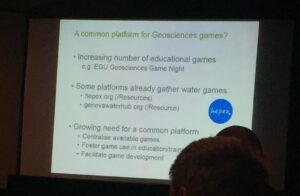 MHR: Long day today! Nice visit to Hydro-Québec, where they explained how they use ESP forecasts, among others. Nice discussions and the question that is always in our minds: can we do better than ESP at seasonal scales?
MHR: Long day today! Nice visit to Hydro-Québec, where they explained how they use ESP forecasts, among others. Nice discussions and the question that is always in our minds: can we do better than ESP at seasonal scales?
After the visit, I attended the “Water-related Education, Training and Capacity development” session. Louise Crochemore (SMHI) presented the idea behind two games developed under the CLARA and IMPREX EU projects. She explained that each game had its own storyline, game objective and decision problem, but both had the same overall goal: try to understand how people use forecasts. She also draw our attention to online platforms that make games publicly available, such as Hepex (here) and the Geneva Water Hub (here). Try it yourself!
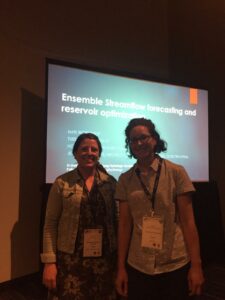 MAB: Finally made it to the conference, one hour before the short course on ensemble streamflow forecasting and reservoir optimisation. We had a nice audience with people from New-Zealand, France, Germany, Rwanda, … with diverse backgrounds, related to hydrology more than hydropower. Most participants said that they were already familiar with hydrological simulations but not forecasts. As it is often the case, Sara and I had prepared waaaay too much material (and I thought maybe I didn’t have enough! Ah! Ah! Ah!). It was a very enthusiastic and participative group.
MAB: Finally made it to the conference, one hour before the short course on ensemble streamflow forecasting and reservoir optimisation. We had a nice audience with people from New-Zealand, France, Germany, Rwanda, … with diverse backgrounds, related to hydrology more than hydropower. Most participants said that they were already familiar with hydrological simulations but not forecasts. As it is often the case, Sara and I had prepared waaaay too much material (and I thought maybe I didn’t have enough! Ah! Ah! Ah!). It was a very enthusiastic and participative group.
There will be several forecasting related sessions tomorrow (both long- and short-term). Much looking forward to learn about new research!
Day 4: Wednesday 10 July
MHR: What a day today! We had our first oral session for the ‘Short-range hydrometeorological forecasting’ and our posters session (see the talks here). The focus of the orals today was on post-processing and data assimilation. There were also the sessions on “Sub-seasonal to seasonal prediction”. Unfortunately I could not attend all these nice talks, since it was overlapping with a workshop on “Research and practice: where is the harmony?”, where I was giving a short talk.
This is Tito at IAHS 2019
A common question in the workshop was: ‘what are the consequences of my scientific activity?’ The discussions highlighted the gaps that still exist between science and practice, and how sometimes practice cannot ‘play’ with scientific ideas (since practitioners do not have time or means to implement complex solutions or they are bound by law to follow specific procedures).
Some possible solutions were mentioned such as creating workgroups that mix researchers and practitioners/operational hydrologists, and facilitating trust building. Communicating is key and one of the speakers, Fabian Tito Arandia Martinez from Hydro-Québec, pointed out that communication comprises also listening to each other.
At the end of the day, we had a session to discuss the new IAHS initiative of 23 Unsolved Problems in Hydrology (UPH). Is your research work related to one of them? Check them out here.
The idea is that these UPHs will facilitate connections (between disciplines and among research studies carried out around the world). Scientific collaboration should be fostered among IAHS commissions and between IAHS and other unions/associations (e.g., EGU, AGU). Everybody is invited to contribute!
Well, it is time to go to bed now because tomorrow will also be a day full of talks and meetings!
ps.: Marie-Amélie is probably already sleeping by now! She worked so hard today to make sure that the sessions went all well! A big ‘thank you’ to her!
Short-range hydrometeorological forecasting session on Wed 10 July at IAHS 2019
MAB: Eh no, not sleeping yet! Today was indeed a bit of work, but we did get an excellent short range hydrometeorological forecasting session in the afternoon. This session included the talk of our solicited speaker Matthieu Lafaysse, about statistical post-processing targeted at snow depth.
One of my highlights of the day was this morning, during the Sub-Seasonal to Seasonal Predictions session. The presentation by Tanja Portele about Seasonal Forecasts for Water Management in Semi-arid Regions included some spatial verification metrics to verify that the forecasts correctly represent the structure, amplitude and location of precipitation objects. Maybe a more careful spatial verification of dynamical long range forecasts will help identify their strengths relative to climatological (ESP) forecasts.
Day 5: Thursday 11 July
Short-range hydrometeorological forecasting session on Thu 11 July at IAHS 2019
MHR: Much of my day today was spent attending the last two ‘short-range forecasting’ oral blocks. Several presentations focused on (near-) operational systems/forecasting chains. When dealing with operational systems the crucial questions seem to be: Does it work? How good are the forecasts?
It is never easy to answer these questions. How many scores do we need to verify if a forecast is good? How can we go beyond case study approaches? How do we measure the ‘happiness of a user’? *okay, that was a question of mine… 😉
One message delivered here was: think well before running a lot of verification scores. Particularly, pay attention to the meaningful spatial and temporal scales to be considered. Additional question: How do we communicate all these scores to the users, while avoiding overflowing them with incomprehensible numerical criteria?
Montreal by night
Another big topic of the oral sessions was high resolution modelling and global to local forecasting. How can a national model complement local models? High resolution models may have their advantages but there is a need to evaluate forecasts against local impacts (which is definitely not as easy as we might think…)
In general, many talks mentioned further developments were targeting incorporating ensemble predictions for improved forecasts! HEPEX has (at least) another 10 years of exciting experiments into the future!
MAB: In addition to Maria-Helena’s detailed account of today’s sessions, I would like to invite people to check out OpenForecast, from one of today’s presentation. Although the system still needs improvements, it is the first open operational streamflow forecasting system in Russia. It relies on easily accessible global data sets and looks quite promising.
Today’s new “Québécois” expression for foreigners: “Organisation de broche à foin*”. Here referring to the last minute organization of tonight’s HEPEX dinner/drinks (it was fun anyways!).
*Disorderly, confused, improvised
Day 6: Friday 12 July
Sometimes, science progresses thanks to (maths-related) movies. The overwhelming amount of informations provided by the MC ratio analysis for a catchment can be filtered by a method inspired by “The imitation game”.
MAB: Today was the continuation of yesterday’s session H16c – Floods: Processes, Forecasts, Probabilities, Impact Assessments and Management. Three main topics were discussed under this broad theme: process understanding, statistical methods related to floods, as well as modeling and forecasting. Two talks of today’s sessions, one this morning and one this afternoon, especially captured my interest. The first one, this morning, proposed a flood typology that also considers scale effects, to categorize flood events into different categories according to their causes. Then, statistical models to estimate the risk of exceeding different flood thresholds can be built separately for different types of floods, allowing for a greater performance and better explaining capabilities.
In the afternoon, under the same session H16c, we learned how Passive Microwave Remote Sensing combined with the Measurement Calibration (MC) ratio allows to estimate entire hydrographs for catchments with various landscape characteristics. Cross-validation on gauged catchment has shown that the hydrographs estimated by this new method are quite close to the real hydrographs, therefore making this technique super interesting for someone who would want to calibrate a model on an ungauged catchment.
Overall, I’m very satisfied with this conference. I’m back home with a head full of ideas and happy to have spent a bit of time with people I like a lot but don’t see very often.
MHR: Zzzzz… I am too tired today; I will tell you all about what I saw and liked today, tomorrow! Promise! Zzzzz…
Day 7: Saturday 13 July
MHR: Today was my last day at the conference, but before telling you how it went, let me first go back to one of the highlights of yesterday: the IAHS plenary.
We had a brief report from the Panta Rhei decade (2013-2022). Fuqiang Tian replaces Giuliano Di Baldassarre as chair of the initiative. He set four targets for the next couple of years: 1) continued growth, with a renewed focus on science in practice and synergies among disciplines; 2) benchmark assessment (data and models for benchmarking – a bit as like it was done in MOPEX, he said); 3) synthesis report (a community reflection is envisaged); and 4) enhance impact, on both hydrologic science and applications.
A brief report on the Hydrological Sciences Journal (HSJ) was also provided. The number of submission has been steadily increasing and the group of associated editors will be increased from 42 to 60. They have now an award for editors and Elena Volpi (Università Degli Studi Roma) was awarded their first editorial award 2019. They are interested in organizing more special issues in HSJ (any Hepex idea?) Also interesting to note: after two years, all papers in HSJ become free to view.
 IAHS has a new president elect: Berit Arheimer from SMHI. As emphasised by the General Secretary, Christophe Cudennec, she is the first woman to be elected for the presidency in the history of IAHS. She will succeed Günter Blöschl in a couple of years. She stated her mission in the plenary: “from fact resistance to factfulness”. She wants to see IAHS as “a one global voice for water”. Maybe HEPEX co-chair Ilias Pechlivanidis, a colleague of Berit at SMHI, can interview Berit for a Hepex blog post? I would be curious to know her opinion on how we can make hydrological ensemble predictions more present at IAHS conferences and activities!
IAHS has a new president elect: Berit Arheimer from SMHI. As emphasised by the General Secretary, Christophe Cudennec, she is the first woman to be elected for the presidency in the history of IAHS. She will succeed Günter Blöschl in a couple of years. She stated her mission in the plenary: “from fact resistance to factfulness”. She wants to see IAHS as “a one global voice for water”. Maybe HEPEX co-chair Ilias Pechlivanidis, a colleague of Berit at SMHI, can interview Berit for a Hepex blog post? I would be curious to know her opinion on how we can make hydrological ensemble predictions more present at IAHS conferences and activities!
At the end of the plenary, the IAHS medals and awards were given: the Tison (HSJ) award was given to Sandra Pool and Marc Vis for the paper “Evaluating model performance: towards a non-parametric variant of the Kling-Gupta efficiency”; the Volker Medal was awarded to Jan Szolgay from the Slovak University of Technology in Bratislava; the Dooge medal was awarded to Alberto Montanari from the University of Bologna (he gave an interesting lecture that you can find available here).
On Saturday, I spent part of the day attending oral presentations on a variety of topics: hydrological signature for model uncertainty, impact of observation uncertainty on model calibration, selection of summary metrics for model calibration (they should have a stronger diagnostic power than residual-based likelihood functions, it was said), understanding structural errors, etc.
At the end of the day, I attended the session “Climate and Hydrological Services: Bridging from Science to Practice and Adaptation“. The presentations were very interesting and I specially enjoyed the one given by Kersten Stahl on linking drought monitoring to impacts (Hydrological Services as an important part of drought monitoring and risk management), where she highlighted the fact that low flow values may not be a good indicator for droughts, as many other factors may affect the hydrological conditions at the onset of droughts, and the one given by Pablo Borges de Amorin (A Web-tool for Synthesizing Scientific Literature: the Impacts of Climate Change on the Brazilian Water Resources), which presented an interesting effort to synthesize (and qualify the consistency of) the many studies on climate change impacts in hydrology that have been carried out in Brazil.
Saturday was also the “IAHS frisbee match day”, a tradition carefully taken care of by our team at Irstea (chek here). I can’t remember who won this time, but I saw they were all having a lot of fun!
Finally, you may be asking yourselves: “Did she eat the poutine or not?” Of course I did ! 🙂
Marie-Amélie and I thank you very much for having followed our posts. We hope you enjoyed reading these lines. The next IAHS conference will be in Montpellier in 2021, from 28 June to 2 July. Save the date!
IAHS Frisbee match and poutine
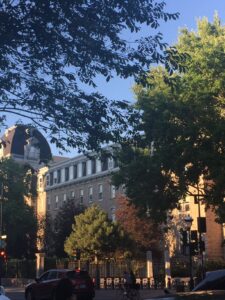
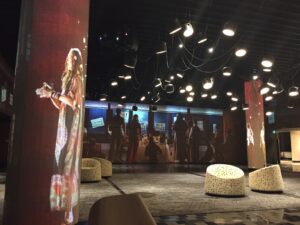
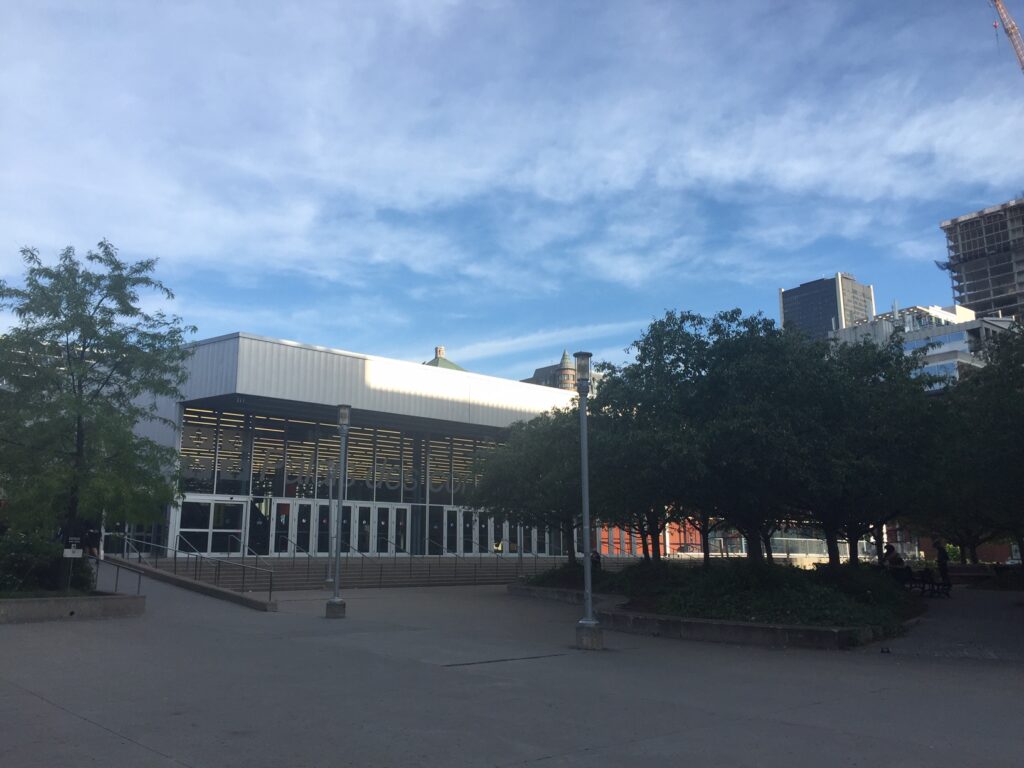
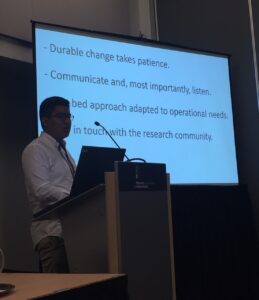
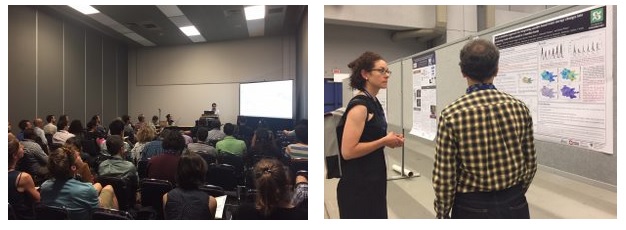



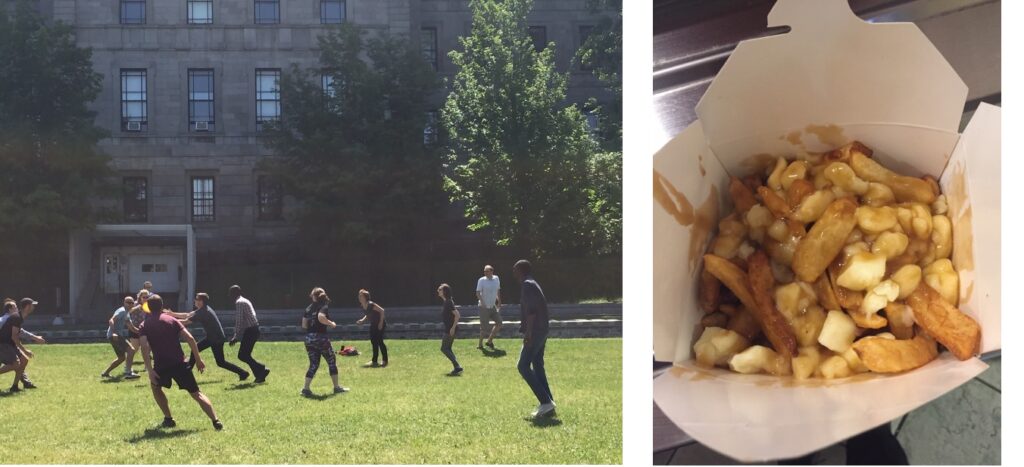
0 comments